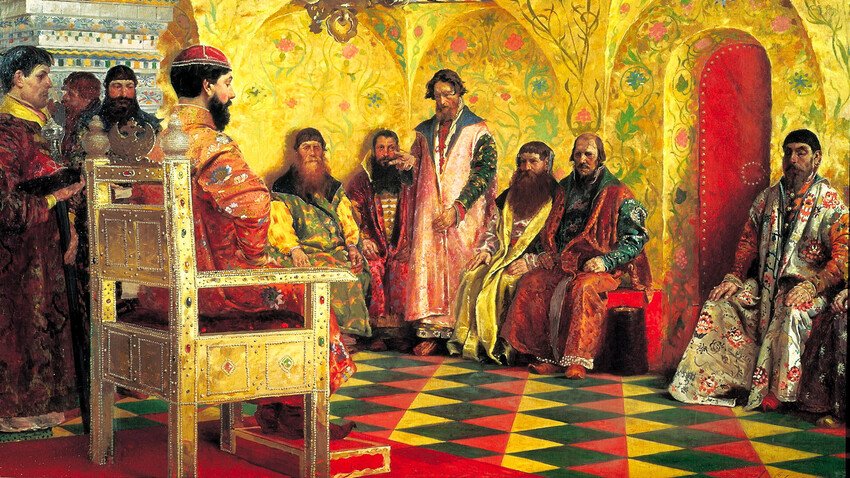
Tsar Mikhail Fedorovich sitting with the boyars, 1893, by Andrei Ryabushkin
Tretyakov Gallery"The tsar is good, the boyars are to blame" has been (and still is) a common phrase in Russia. The boyars often became an object of popular hatred. It was them that the tsar himself often vented their anger on. In 1660, the Russian army was utterly defeated at the hands of the Polish-Lithuanian one. At a meeting of the Boyar Duma, the tsar's father-in-law, boyar Ivan Miloslavsky, announced that if the tsar gave him an army, he would return with the Polish king as prisoner. Tsar Alexey Mikhailovich was furious at such insolence from the boyar, who had previously participated in no more than two or three battles. The Tsar slapped his boyar, pulled his beard, and kicked him out of the Duma chamber.
Such scenes were not uncommon in Moscow – the boyars were the ones many state failures were blamed on, and not always without reason. By the 17th century the boyars began to seriously hinder the development of the country. Under Peter the Great, the Boyar Duma, the government of the Moscow tsardom, no longer assembled, as the system of government had fundamentally changed, and the boyars had no place in it. Who were the boyars and why did they become obsolete?

S. V. Ivanov. Congress of Princes in Uvetichi
Kostroma Regional Museum of Fine ArtsThe boyars were noblemen, representatives of ancient clans, who served the Russian princes in times of war and peace. But one cannot understand the boyars without understanding what constituted their income and subsistence.
Russian lands before the Mongol-Tatar invasion were politically similar to medieval Europe, where the main form of land ownership was an allod (Old Low Franconian for “fully owned estate”) – a landholding which was in inalienable use of a noble family and was passed down in it by inheritance. Russian ‘allods' were called votchinas (“the one belonging to the father”), – the name itself reminds that such ownership was passed from father to son. Votchinas could not be sold, divided or exchanged – in case of violation of these rules, they were alienated from the owner and passed to another member of his family. Votchinas were hereditary possessions of Russian princes – in 1097, at the Council of Liubech, the Russian princes, in an effort to stop the feudal war between them, accepted the rule "Let every prince govern his estate". The boyar land properties (votchinas) were also patrimonial.
The origin of the word "boyar" is not completely clear, but in Old Russian it already existed in this form. The boyars in Russia were absolute masters of their votchinas. Living on their territories were peasants and artisans, who paid the boyar and worked for him in exchange for the protection provided by the noble warlord. Of course, the boyars, together with the princes, participated in military campaigns against neighboring principalities (one of the variants of the origin of the word ‘boyar’ is from the word boy, - “battle” in Russian).
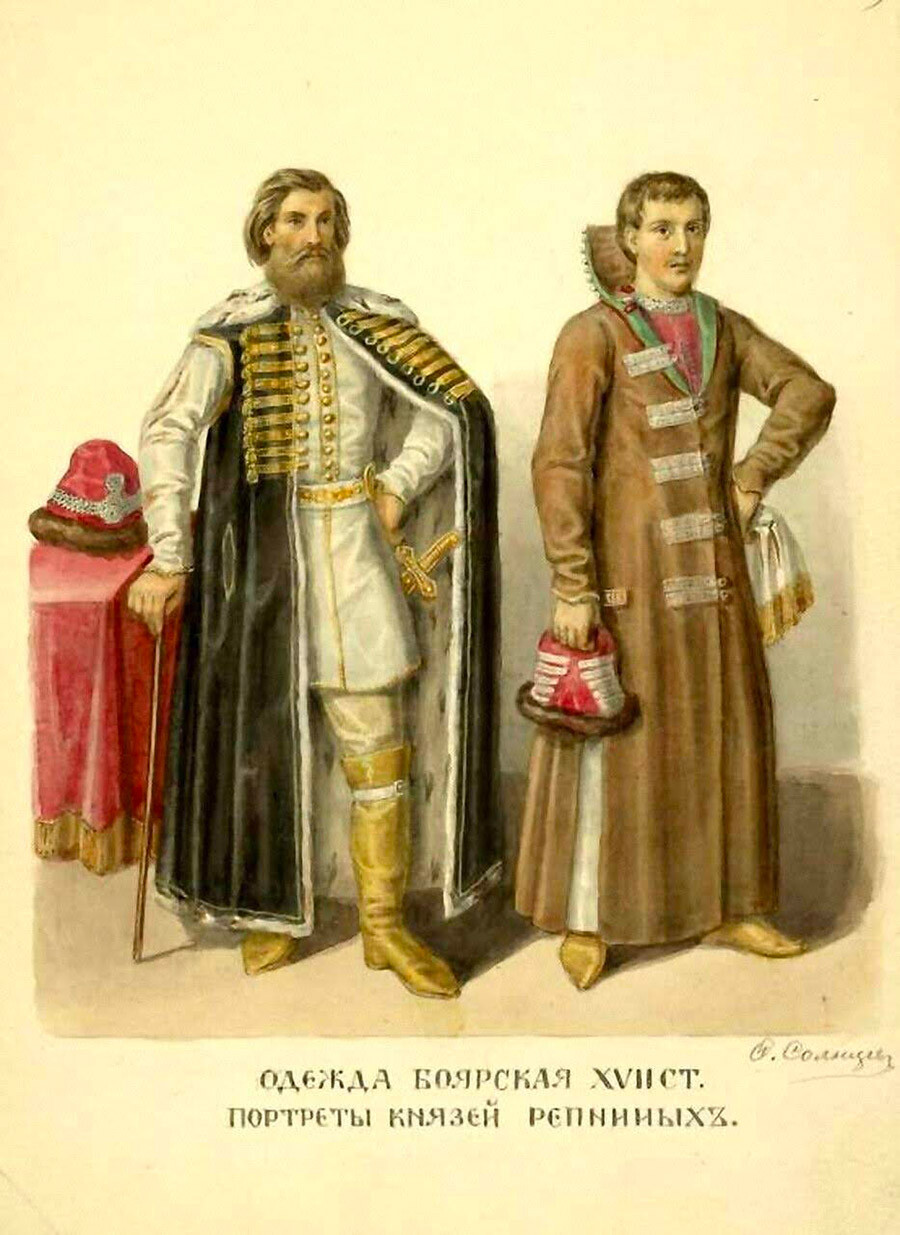
The boyar clothing of the 17th century by Fedor Solntsev
Public domainBut the boyars in this case were not simple servants of the prince – they enjoyed a privileged position in relation to the armed forces, as they could head armies together with princes. Boyars could also become principal statesmen in some territories – for example, a prince could install a boyar as a voevoda (military commander) in any of his towns, and the boyar in this case was responsible for collecting taxes, providing for the military needs of the city, and so on. At the same time, the boyar could freely choose which prince to serve: in the pre-Mongolian period, a boyar could depart to serve another prince, and in doing so retain his votchina and its population. The period following the Mongol-Tatar invasion brought on significant changes to the role and position of the boyars.
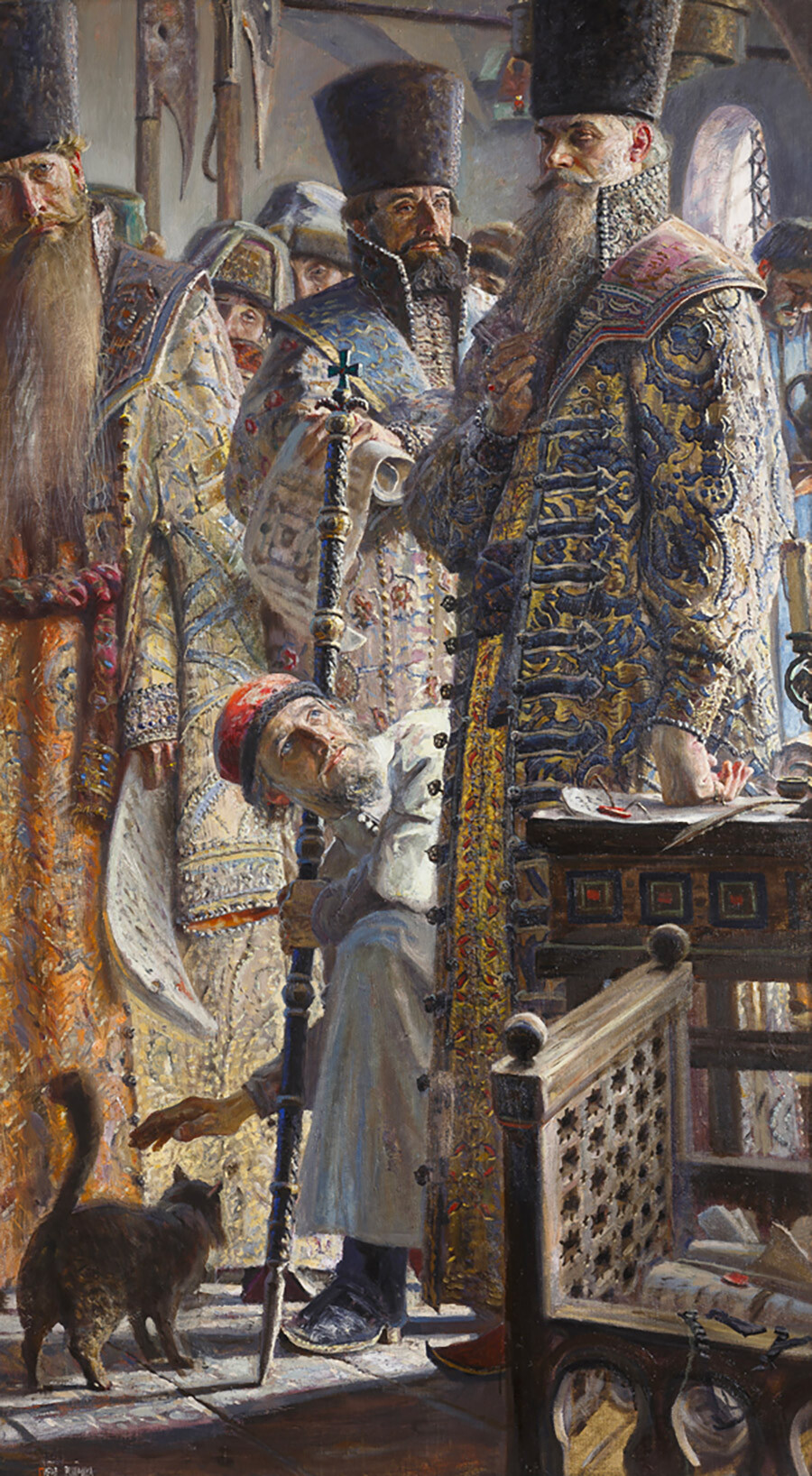
Tsar Fedor Ioannovich by Pavel Ryzhenko
Pavel RyzhenkoWhen the Mongol army invaded Russian lands in the 13th century, Russian princes continued their war, which helped the Mongols: not being able to unite in a single army because of their conflicts, the Russians tried to repel the enemy from separate lands and cities – a strategy which was doomed to failure.
By the 15th century, the situation was different. The Golden Horde itself fell under the attacks of the army of Timur, and split up. Russian princes joined their forces under the leadership of Moscow to stop paying tributes to the Horde. During this time, the boyars were written up to the "boyar books," compiled by the central authorities in Moscow. They recorded the names, positions and functions of the boyars. By then, the boyars were divided into elder boyars and lower-class boyars. The ‘elders’ served the Grand Prince of Moscow personally. Thus, ‘the bed boyar’ (‘postelnichiy’) was the person who visited the prince first thing in the morning and informed him of all the latest news – an important and very influential position. The "stable boyar", meanwhile, dealt with all the matters of providing, feeding, and training the prince's horses; and the "falcon boyar" was in charge of the prince's falcon hunts, and so on.

The Russian Embassy to the Holy Roman Emperor Maximilian II in Regensburg, 1576
Public domainThis accounting was needed because, with the centralization of the state, the number of boyars increased. Many of the former princes came to the service of the Grand Prince of Moscow and became his boyars. The Boyar Duma was formed, which was a kind of government that collectively (but under the leadership of the prince) presided over state issues. The members of the Boyar Duma occupied the highest positions after the prince. They shared almost their entire day with the prince – getting up before dawn, sitting in the Duma from early morning (from 5 o'clock), then attending feasts, hunting with the prince, and so on.
The boyars, who were not included in the Duma, participated in military campaigns, led troops, acted as voevodas in the cities, and so on. But the main change experienced by the Russian nobility after Moscow became the center of power affected the status of their land tenure.

Ivanov S. V. "The Great Sovereign, tsar and autocrat of All Russia" (Tsar Alexey Mikhailovich)
Public domainAfter 1480, when Moscow finally stopped paying tribute to the Golden Horde, the boyars began to pressure the central government outright. Owning their own estates, like the princes owned their duchies, the boyars did not want to part with their independent status – they cared more about it than state affairs. Boyars were constantly involved in career disputes. For example, they refused to go on military campaigns if their position in the army was lower than that of their fathers.
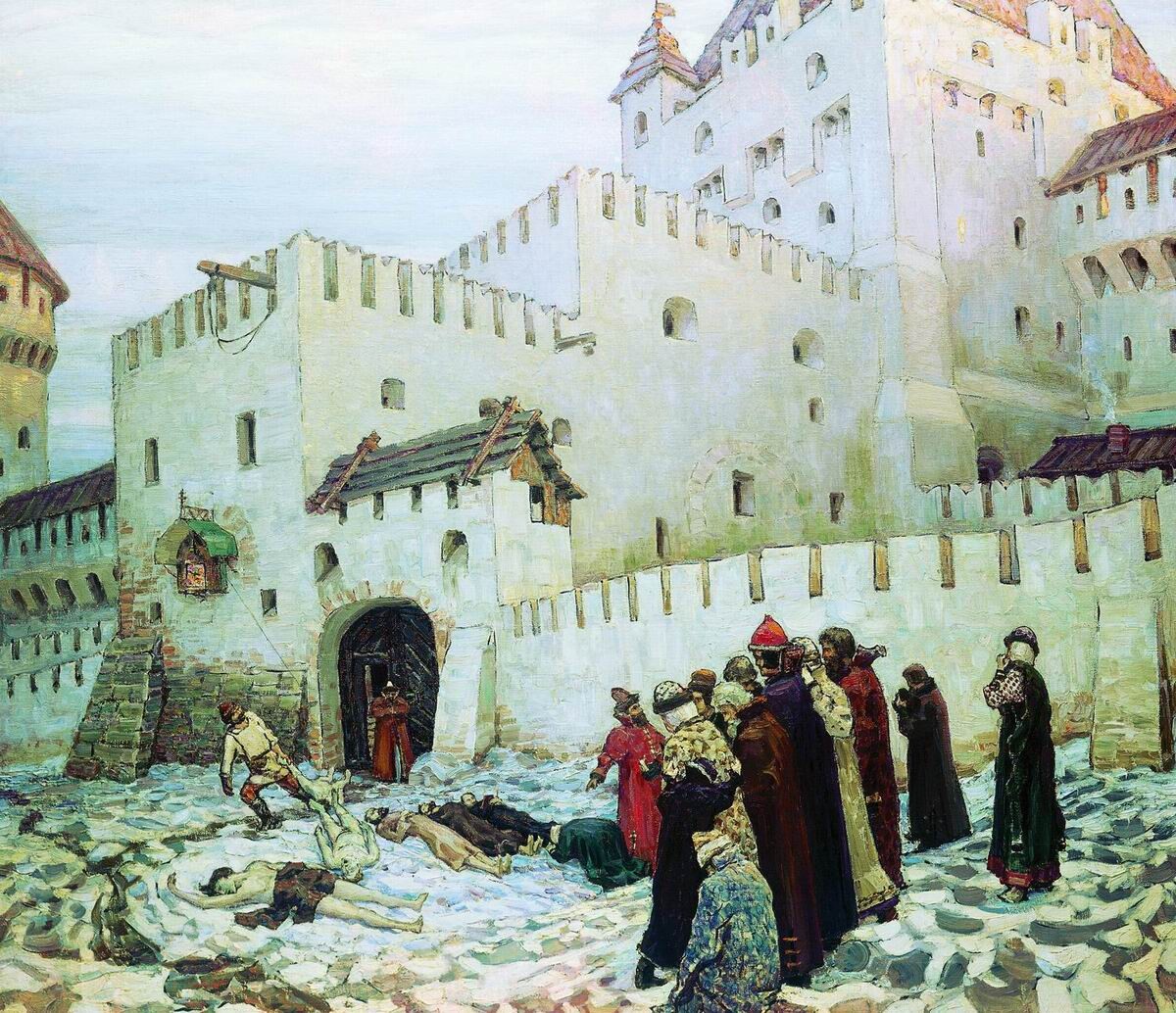
"The backyard of the Moscow prison", by Apollinariy Vasnetsov
Museum of MoscowIvan the Terrible, the first tsar of Moscow, began to deliberately fight the boyars. The main purpose of the "oprichnina" was the forcible alienation of estates from the boyars who owned them. Even before the oprichnina, on January 15, 1562, Ivan issued an ukaz, which forbade the boyars and princes, who served the tsar, to sell, exchange or give as dowry their estates under threat of confiscation. In the absence of a direct male heir in the family, the estates were transferred directly to the tsar. The boyars started fleeing the Moscow tsardom. Those caught were exiled, punished, or executed. And just before the introduction of the oprichnina, Ivan left Moscow, claiming that his decision was due simply to his anger at the boyars and princes. The Tsar came back only on the condition that he would be free to execute the traitors and deprive them of their property.
The oprichnina was, in fact, a mass repression against the boyars and Rurikid princes. However, amid the devastation and the resettlement of the nobility to other lands, ordinary peasants suffered as well – they fled from the lands of impoverished or executed landlords. According to historian Vladimir Kobrin, "first decades after the oprichnina… [give the impression that] the country experienced a devastating enemy invasion.” The result of the careless anti-boyar policy of Ivan the Terrible was, in fact, the impoverishment of the entire tsardom – primarily due to the fact that more than half of the arable land would remain uncultivated for years. And the peasants who fled began to be forcibly retained, forbidding from moving to other lands, thus laying the foundations of serfdom, which finally became firmly established in the 17th century.
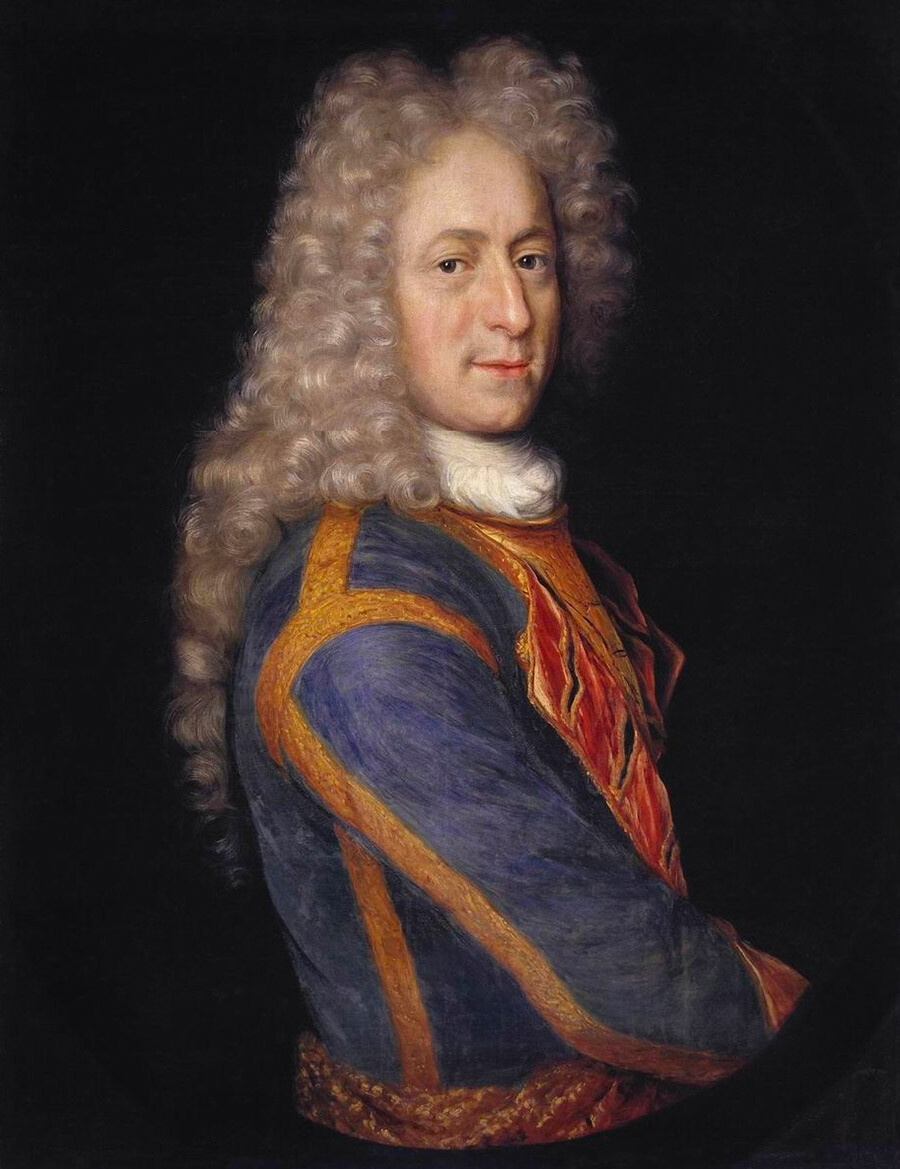
Prince Ivan Trubetskoy, by an unknown artist
Tretyakov GalleryIt is ironic that the horrors of the oprichnina and the ensuing Time of Troubles led to the restoration of boyar power. And it immediately revealed its worst side. “The Seven Boyars", the boyar government of 1610-1612, first deposed Tsar Vasily Shuisky, then signed a treaty with the Poles, according to which Prince Wladyslaw (Vasa) became the Tsar of Russia, and then boyars simply let the Poles into the Kremlin – and became their hostages. Nevertheless, the Boyar Duma in the 17th century, even under the first Romanovs, worked very hard. No decision was taken without it. And, most importantly, endless disputes had continued. What could the tsar possibly do to oppose the power wielded by the old nobility?
One method used against the boyars was actually invented by the grandfather of Ivan the Terrible – Grand Prince Ivan III of Moscow, the victor over the Golden Horde and the founder of the Russian state. It was his Code of Laws of 1497 that laid the foundations for a new type of estate – the pomestie (manor). Unlike votchinas, which belonged to boyars and princes by right of kinship, the Moscow tsar granted manors to his servants as both a reward for service and as a source of income, which allowed servants to equip themselves for military campaigns. Unlike votchinas, manors could be "issued" both for life and for the term of service; they could also become hereditary or returned to the sovereign after the death of a servant – in the 15-16th centuries the manors were the property of landlords only insofar as the landlord was in the sovereign's service. Thanks to the massive distribution of manors, which began under Ivan III, the Moscow tsardom created a new army. However, If the old boyars resembled European feudal lords in status, the vassals of their prince, the ‘new’ noblemen were, much less independent, their property could disappear overnight if they came into conflict with the central government.
The system of manors, established by Ivan III, came very handy by the end of the 17th century, and it was on its basis that Peter the Great built a new Russian army. The principle of its staffing was succinctly formulated by Peter in his decree of 1701: "all servicemen with lands serve the state, and no one owns lands for doing nothing.” Now the pomeshchiki – the owners of manors, not the landed gentry – became the agents of the authorities in the collection of taxes, land management, and, most importantly, the recruitment of soldiers from the peasantry. It was also important that the average landlord, unlike a boyar, was very poor – not all manors could feed their owners, and were, therefore, forced to join the military or civil service to receive wages.
In 1714, the so-called "Decree of Primogeniture" finally equalized the estates and manors (pomesties) under the title of "immovable property". The decree made the property hereditary, but forbade its division and sale among the descendants, except in cases of extreme necessity. In addition, since the estate could only be transferred to one of the sons (not necessarily the eldest), all other descendants were forced to go into public service in order to earn a living.
And yet, Peter still awarded four of his associates the title of boyar – already in the 18th century. All these four men – Shakhovskoy, Apraksin, Neledinsky-Meletsky, Buturlin – belonged to the old Moscow families, and the boyar status, obtained in old age, amounted to nothing more than a symbolic status for them. The Boyar Duma was no more.
The last boyar of Russia was Prince Ivan Trubetskoy, who died in 1750. He combined the title of boyar with military ranks already received under Peter's Table of Ranks, while also performing the function of senator. It was the Governing Senate under Peter that replaced the Boyar Duma as the government of the Russian state.
If using any of Russia Beyond's content, partly or in full, always provide an active hyperlink to the original material.
Subscribe
to our newsletter!
Get the week's best stories straight to your inbox